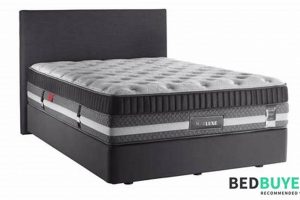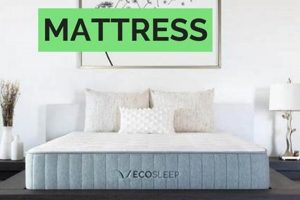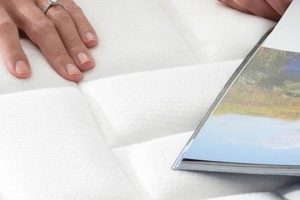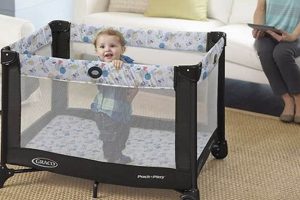Selecting appropriate bedding is crucial for maximizing the comfort and support provided by memory foam mattresses. The ideal sheets should complement the material’s properties, enhancing temperature regulation and ensuring a comfortable sleep surface. Considerations include fabric type, weave, and thread count, all of which contribute to the overall feel and performance.
The correct bedding choice influences sleep quality and the lifespan of the mattress. Bedding that breathes well helps dissipate heat, preventing overheating. Moreover, well-chosen sheets can protect the mattress from wear and tear, preserving its integrity and prolonging its useful life. Historically, the evolution of mattress technology has driven innovation in bedding design, leading to specialized options that cater to specific mattress types.
The following sections will delve into specific fabric types and constructions suitable for optimizing the experience with memory foam mattresses, providing guidance on selecting bedding based on individual preferences and needs.
Selection Guidance
The following outlines factors to consider when selecting bedding to complement memory foam mattresses.
Tip 1: Prioritize Breathable Fabrics: Natural fibers like cotton, linen, and bamboo offer superior breathability. These materials promote airflow, mitigating heat retention commonly associated with memory foam.
Tip 2: Consider Weave: Percale weave provides a crisp, cool feel due to its tighter weave structure. Sateen weave offers a smoother, silkier texture, though it may retain more heat.
Tip 3: Evaluate Thread Count Wisely: While high thread count is often associated with quality, excessive thread count can impede breathability. Focus on thread counts between 300 and 500 for optimal balance.
Tip 4: Opt for Fitted Sheets with Adequate Depth: Memory foam mattresses often have considerable depth. Ensure the fitted sheet has pockets deep enough to accommodate the mattress height without stretching or slipping.
Tip 5: Explore TENCEL Lyocell: This fabric is derived from wood pulp and is known for its exceptional moisture-wicking properties and soft feel, making it suitable for individuals who tend to sleep hot.
Tip 6: Check for Certifications: Look for certifications such as Oeko-Tex Standard 100, which indicates that the bedding has been tested for harmful substances and is safe for use.
Tip 7: Consider Personal Temperature Preferences: Individuals who tend to overheat should prioritize cooling fabrics and weaves, while those who prefer a warmer sleep environment may opt for denser materials.
Careful consideration of these factors ensures the selected bedding enhances the comfort and performance of the memory foam mattress.
The following sections will explore specific product recommendations, categorized by fabric type and features.
1. Breathability
Breathability in bedding is paramount when paired with memory foam mattresses due to the material’s inherent tendency to retain heat. Selecting sheets that promote airflow is critical for mitigating overheating and ensuring a comfortable sleep environment.
- Fiber Type and Airflow
The type of fiber directly influences breathability. Natural fibers, such as cotton, linen, and bamboo, possess superior wicking and ventilation properties compared to synthetic alternatives. These materials allow air to circulate, drawing heat away from the body. For instance, percale cotton, with its loose weave, facilitates enhanced airflow, reducing heat buildup.
- Weave Structure and Ventilation
The weave of the fabric is another determinant of its breathability. A looser weave allows for greater air permeability. Examples include percale, known for its crisp feel and airy structure, and muslin, which is exceptionally lightweight and breathable. Tightly woven fabrics, while often softer, tend to trap more heat. Sateen, for instance, has a denser weave that can impede airflow.
- Moisture Wicking and Evaporation
Effective moisture wicking is intrinsically linked to breathability. Fabrics that can absorb and evaporate moisture efficiently help regulate body temperature. Materials like TENCEL Lyocell excel at wicking moisture away from the skin, promoting a cooler and drier sleep surface. This is particularly beneficial for individuals prone to night sweats.
- Impact on Sleep Quality
Sheets that lack breathability can disrupt sleep patterns, leading to restlessness and discomfort. Overheating can prevent the body from reaching the optimal temperature for sleep initiation and maintenance. Selecting breathable bedding can improve sleep latency, reduce nighttime awakenings, and enhance overall sleep quality when using memory foam mattresses.
The interplay between fiber type, weave structure, moisture-wicking capabilities, and their ultimate impact on sleep quality underscores the importance of prioritizing breathability in bedding choices for Tempurpedic mattresses. Selecting sheets designed to enhance airflow and temperature regulation is essential for maximizing comfort and promoting restful sleep.
2. Temperature Regulation
Temperature regulation is a critical performance attribute in bedding designed for memory foam mattresses. Memory foam’s dense structure can impede airflow, potentially leading to heat retention and discomfort. Therefore, sheets that actively facilitate temperature regulation become essential for maintaining a comfortable sleeping environment. Sheets with poor temperature regulation qualities paired with memory foam can lead to night sweats, restlessness, and disrupted sleep cycles.
Effective temperature regulation is achieved through several mechanisms. The choice of fabric is paramount; breathable materials such as cotton, linen, TENCEL, and bamboo allow for air circulation and moisture wicking. For example, percale cotton, with its open weave, promotes airflow, while TENCEL excels at drawing moisture away from the body. The weave structure also plays a significant role. Looser weaves, such as percale or muslin, are more breathable than tighter weaves like sateen. Furthermore, the moisture-wicking capabilities of the fabric contribute to temperature regulation by dissipating perspiration. Materials that trap moisture exacerbate heat retention, counteracting the benefits of the mattress.
In summary, temperature regulation is an integral component of selecting appropriate bedding for memory foam mattresses. Choosing sheets with breathable fabrics, open weaves, and effective moisture-wicking properties mitigates the potential for heat retention, ensuring a cooler and more comfortable sleep experience. Overlooking this aspect can negate the benefits of the mattress its
elf, resulting in compromised sleep quality.
3. Fabric Softness
Fabric softness is a crucial sensory characteristic directly impacting perceived comfort and overall sleep quality when selecting sheets for memory foam mattresses. It influences tactile satisfaction and the immediate sense of well-being upon contact, directly affecting the user’s willingness to remain at rest. Sheets offering inadequate softness can detract from the conforming support provided by the mattress, leading to discomfort and potentially disrupting sleep.
- Fiber Composition and Tactile Feel
The inherent properties of different fibers significantly dictate fabric softness. Natural fibers like long-staple cotton (e.g., Egyptian or Pima cotton), silk, and bamboo-derived rayon (e.g., viscose or modal) are often prized for their inherent softness. These fibers possess a smoother surface and greater flexibility compared to coarser alternatives such as short-staple cotton or synthetic blends. The softness of these fibers contributes to a more pleasant tactile experience against the skin. For example, Pima cotton sheets offer a luxuriously soft feel due to the long, smooth fibers, minimizing friction and maximizing comfort. The choice of sheet material can therefore affect the user’s sleep experience.
- Weave and Surface Texture
The method of weaving fibers together significantly impacts the resulting fabric’s texture and perceived softness. Sateen weaves, for instance, create a smooth, lustrous surface due to the way the weft threads float over multiple warp threads, minimizing the number of interlacings. This results in a softer, more supple feel compared to percale weaves, which have a tighter, crisper texture. However, sateen weaves may be less durable and retain more heat, a factor to consider when pairing with heat-sensitive memory foam. An alternative might be a brushed microfiber to offer a high degree of smoothness
- Chemical Treatments and Finishing Processes
Various chemical treatments and finishing processes can alter a fabric’s softness. Softening agents, such as silicone-based finishes, can be applied to fabrics to enhance their tactile feel. However, these treatments may degrade over time with repeated washing, diminishing the initial softness. Furthermore, the use of harsh chemicals in these processes can impact the fabric’s durability and breathability. Therefore, it is essential to consider the long-term effects of such treatments and prioritize bedding that utilizes environmentally friendly softening methods. For example, the process of mercerization can result in a smoother final product, offering higher durability and softness levels.
- Individual Sensitivity and Preferences
Perception of fabric softness is subjective and varies among individuals. Some individuals may prefer the crisp feel of percale, while others prioritize the smooth, silky texture of sateen or microfiber. Factors such as skin sensitivity, allergies, and personal preferences play a role in determining the ideal level of softness. It is important to consider these individual factors when selecting sheets for memory foam mattresses. A trial period or the availability of sample swatches can help determine the most suitable option. An effective example is considering a sheets hand, a term referring to how the fabric feels when handled and rubbed against the skin.
The importance of fabric softness when selecting sheets for memory foam mattresses cannot be understated. The careful consideration of fiber composition, weave structure, chemical treatments, and individual preferences directly contributes to a more comfortable and restful sleep experience, enhancing the benefits of the mattress. Softness can be as critical as any aspect in optimizing the quality of sleep.
4. Proper Fit
The term “proper fit,” in the context of selecting sheets for a memory foam mattress, denotes the degree to which the fitted sheet conforms to the mattress dimensions without excessive stretching, bunching, or slippage. Achieving a proper fit is paramount to both comfort and the longevity of the bedding.
- Pocket Depth and Mattress Height
Pocket depth refers to the measurement of the fitted sheet’s corner, which determines its ability to accommodate the thickness of the mattress. Memory foam mattresses often exceed standard depths, necessitating sheets with deep pockets (typically ranging from 12 to 18 inches). Failure to select sheets with sufficient pocket depth results in the fitted sheet repeatedly slipping off the corners, causing discomfort and premature wear. As an example, a 14-inch mattress paired with standard-pocket sheets would likely experience chronic corner detachment.
- Elastic Quality and Tension
The quality and tension of the elastic band sewn into the perimeter of the fitted sheet are critical for maintaining a secure fit. A robust, high-tension elastic band ensures that the sheet remains taut and in place, even with movement during sleep. Conversely, a weak or overstretched elastic band loses its ability to grip the mattress, leading to slippage and bunching. This can be exemplified by observing a low-quality sheet’s elastic stretching excessively after only a few uses, demonstrating its inability to maintain a proper fit.
- Sheet Dimensions and Mattress Size
Ensuring that the overall dimensions of the sheet set (flat sheet and fitted sheet) correspond precisely to the mattress size (Twin, Twin XL, Full, Queen, King, California King) is fundamental to achieving a proper fit. Selecting a sheet set designed for a larger mattress results in excess fabric, leading to bunching and discomfort. Conversely, attempting to fit sheets intended for a smaller mattress often leads to tearing or excessive stretching, compromising the material’s integrity. If a Queen-sized mattress is paired with a Full-sized sheet, the user would find the sheet difficult to impossible to properly place, and it would tear over time.
- Construction and Corner Reinforcement
The construction of the fitted sheet, including reinforced corners and durable stitching, contributes significantly to its ability to maintain a proper fit. Reinforced corners prevent tearing and ensure that the elastic band is securely anchored. Durable stitching prevents seams from unraveling, which can compromise the overall shape and fit of the sheet. An example of superior construction can be seen in sheets that have an extra layer of fabric sewn into the corners to prevent tearing after repeated uses.
The interrelationship between these factors underscores the necessity of prioritizing proper fit when selecting sheets for a memory foam mattress. Addressing pocket depth, elastic quality, sheet dimensions, and construction ensures that the sheets remain securely in place, maximizing comfort and extending the lifespan of both the sheets and the mattress.
5. Durability
Durability is a paramount consideration when selecting bedding for memory foam mattresses. The longevity of sheets is directly related to their ability to withstand regular use and laundering without significant
degradation in quality or performance. The repetitive compression and friction exerted by the body on the sheets, combined with the cleaning process, necessitate a robust construction and high-quality materials to prevent premature wear and tear. For instance, sheets constructed from short-staple cotton fibers may pill excessively and lose their shape after only a few washes, diminishing both comfort and aesthetics. The selection of durable sheets, therefore, represents a long-term investment in sleep quality and cost-effectiveness.
The correlation between durability and material composition is evident in the performance of various fabrics. Long-staple cotton fibers, such as Egyptian or Pima cotton, exhibit superior resistance to abrasion and pilling compared to their short-staple counterparts. Similarly, linen, known for its inherent strength, demonstrates exceptional durability, often becoming softer and more comfortable with repeated washing. Synthetic blends, while sometimes offering cost advantages, may lack the breathability and moisture-wicking properties of natural fibers, potentially leading to discomfort and reduced overall satisfaction. The significance of durability extends beyond mere longevity; it influences the sheets’ ability to maintain their shape, color, and texture, thereby preserving the integrity of the sleep environment.
In conclusion, durability is an indispensable characteristic of high-quality bedding designed for memory foam mattresses. The selection of sheets constructed from durable materials, such as long-staple cotton or linen, ensures resistance to wear, retention of shape, and sustained comfort over an extended lifespan. Overlooking durability can result in frequent replacements, increased costs, and a compromised sleep experience. Prioritizing durability, therefore, aligns with both practical and economic considerations, contributing to a more restful and sustainable sleep environment.
6. Moisture Wicking
Moisture wicking is a critical attribute in bedding, particularly when paired with memory foam mattresses. The material’s density can restrict airflow, increasing the potential for heat retention and perspiration. Sheets with effective moisture-wicking properties are therefore essential for maintaining a comfortable and dry sleep environment.
- Fiber Composition and Moisture Transport
The fiber content of sheets directly influences their moisture-wicking capabilities. Natural fibers, such as merino wool, Tencel Lyocell, and bamboo, possess superior moisture-wicking properties compared to synthetic alternatives. These fibers draw moisture away from the skin and facilitate evaporation, preventing the buildup of perspiration. For instance, Tencel fibers can absorb significantly more moisture than cotton, contributing to a drier sleeping surface. Conversely, synthetic fibers like polyester tend to trap moisture, leading to discomfort.
- Weave Structure and Air Permeability
The weave structure of the fabric influences its ability to transport moisture. Loosely woven fabrics, such as percale, promote air permeability, allowing moisture to evaporate more readily. Tightly woven fabrics, such as sateen, may impede airflow, reducing the effectiveness of moisture wicking. The weave affects the overall performance of the sheet in maintaining a dry sleep environment. An example would be comparing linen (a less dense, looser weave) with a high thread count sateen weave, where the former will provide better moisture wicking and air permeability, even with similar fiber content.
- Impact on Temperature Regulation
Effective moisture wicking plays a pivotal role in regulating body temperature during sleep. By drawing moisture away from the skin, these sheets prevent the body from overheating and reduce the likelihood of night sweats. This contributes to a more consistent and comfortable sleep temperature, reducing the need for adjustments during the night. Poor temperature regulation can lead to disrupted sleep cycles and discomfort. Materials like merino wool not only wick away moisture, but they can insulate against changes in temperature.
- Influence on Mattress Hygiene
Sheets with effective moisture-wicking properties contribute to the hygiene of the mattress itself. By preventing the accumulation of sweat and moisture, these sheets reduce the risk of mold and bacterial growth within the mattress. This is particularly relevant for memory foam mattresses, which are prone to moisture retention. Selecting sheets with moisture-wicking capabilities helps to prolong the lifespan of the mattress and maintain a cleaner sleep environment. This is relevant to mattresses with non-removable covers that are difficult to launder. Over time, moisture can degrade the mattress, causing odors and the breakdown of materials.
The aforementioned factors underscore the importance of prioritizing moisture wicking when selecting bedding for memory foam mattresses. Choosing sheets with appropriate fiber content, weave structure, and moisture-wicking properties ensures a drier, more comfortable, and more hygienic sleep environment, maximizing the benefits of the mattress itself.
Frequently Asked Questions
The following addresses common inquiries regarding the selection of appropriate bedding for memory foam mattresses, specifically addressing the interaction between sheets and mattress characteristics.
Question 1: What specific sheet materials are most compatible with memory foam mattresses?
Optimal sheet materials include natural fibers such as long-staple cotton (e.g., Egyptian or Pima), linen, and TENCEL Lyocell. These materials offer enhanced breathability and moisture-wicking capabilities, mitigating the potential for heat retention often associated with memory foam. Synthetic blends are generally less desirable due to their reduced breathability.
Question 2: How does thread count influence the performance of sheets on a memory foam mattress?
While high thread count is often associated with quality, excessive thread count (above 500) can impede airflow. A thread count between 300 and 500 typically strikes a balance between softness and breathability, promoting a more comfortable sleep environment. Focus should be directed toward material and weave type, rather than solely relying on thread count.
Question 3: Should fitted sheets for memory foam mattresses possess deep pockets?
Given that memory foam mattresses often exceed standard depths, fitted sheets should indeed feature deep pockets (typically 12 to 18 inches). This ensures a secure fit, preventing the sheet from slipping off the corners and maintaining a smooth sleep surface. Measuring the mattress depth prior to purchasing sheets is recommended.
Question 4: Does the weave type of the sheets impact temperature regulation?
The weave type significantly influences temperature regulation. Percale weaves, characterized by their crisp and open structure, promote airflow and dissipate heat effectively. Sateen weaves, while softer, possess a tighter structure that can retain more heat. The selection should align with individual temperature preferences.
Question 5: What certifications should one seek when purchasing sheets for a memory foam mattress?
Certifications such as Oeko-Tex Standard 100 indicate that the sheets have been tested for harmful substances and are safe for use. This ensures that the bedding meets established environmental and safety standards, minimizing the risk of al
lergic reactions or skin irritation.
Question 6: How frequently should sheets for a memory foam mattress be laundered?
Sheets should be laundered at least once per week to maintain hygiene and prevent the accumulation of dust mites, allergens, and body oils. Adhering to the manufacturer’s care instructions is crucial for preserving the integrity and extending the lifespan of the sheets.
Optimal performance of memory foam mattresses is best achieved through pairing with suitable bedsheets, accounting for breathability, temperature regulation and hygiene.
The following section will summarize recommendations for maintenance of the mattresses in question to prolong their longevity.
Best Sheets for Tempurpedic Mattress
This article has explored the multifaceted considerations involved in selecting bedding that complements Tempurpedic mattresses. Key elements identified include breathability, temperature regulation, fabric softness, proper fit, durability, and moisture-wicking capabilities. The interplay of these factors significantly influences the comfort and longevity of both the sheets and the mattress. Informed selection, guided by fiber composition, weave structure, and individual preferences, is crucial for optimizing sleep quality.
Therefore, consumers are encouraged to critically evaluate bedding options based on the criteria outlined, recognizing that appropriate sheets are not merely an accessory but an integral component of a comprehensive sleep system. Prioritizing these factors will contribute to a more restful and hygienic sleep environment, maximizing the benefits of the Tempurpedic mattress investment.


![Top-Rated: Choosing the Best Mattress Foundation [Guide] Organic & Natural Mattress Buyer’s Guide: Non-Toxic Sleep Solutions Top-Rated: Choosing the Best Mattress Foundation [Guide] | Organic & Natural Mattress Buyer’s Guide: Non-Toxic Sleep Solutions](https://mattressworldpa.com/wp-content/uploads/2025/07/th-7633-300x200.jpg)




![How to Find the Best Way Twin Air Mattress [Guide] Organic & Natural Mattress Buyer’s Guide: Non-Toxic Sleep Solutions How to Find the Best Way Twin Air Mattress [Guide] | Organic & Natural Mattress Buyer’s Guide: Non-Toxic Sleep Solutions](https://mattressworldpa.com/wp-content/uploads/2025/07/th-7628-300x200.jpg)